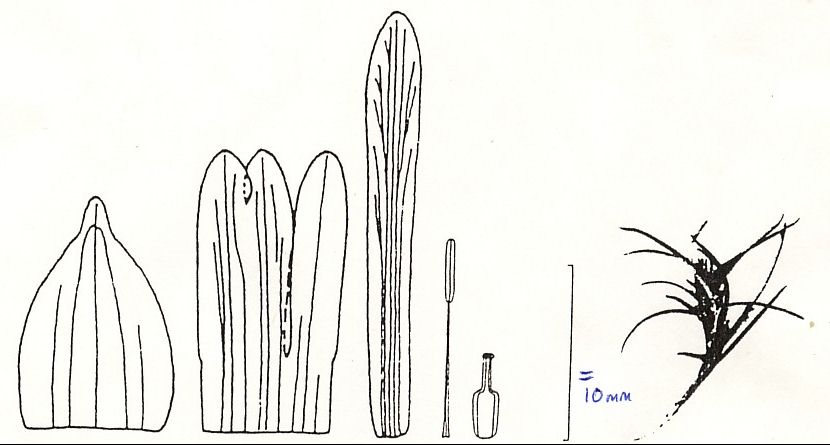

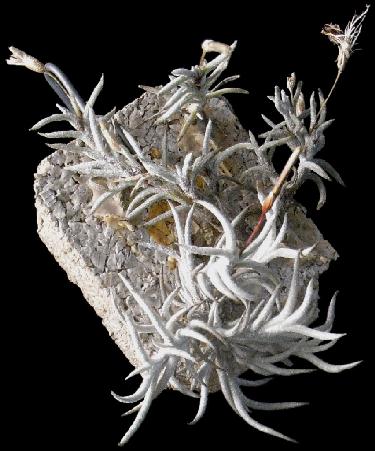
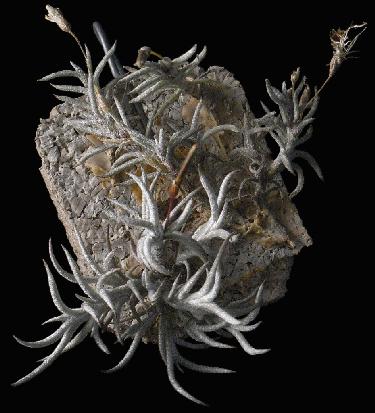

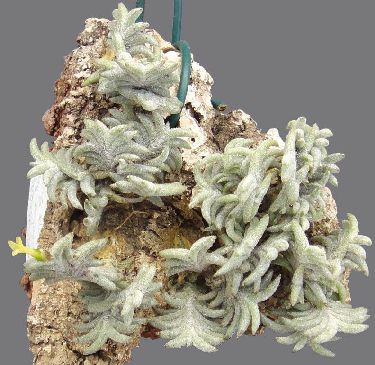
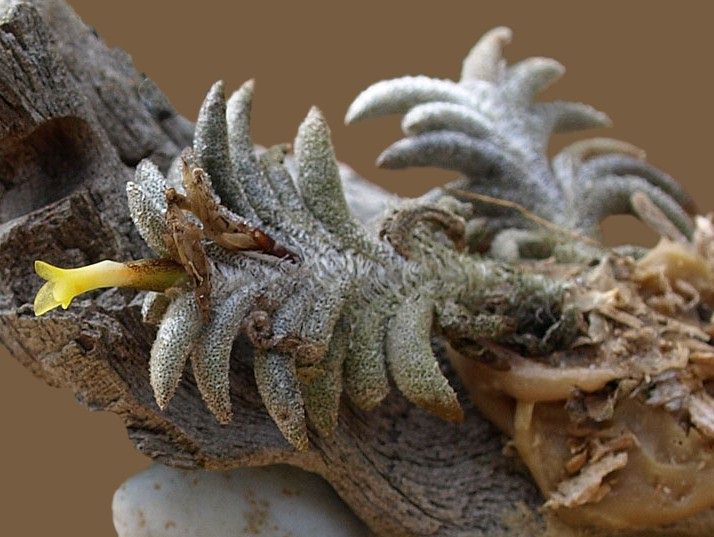
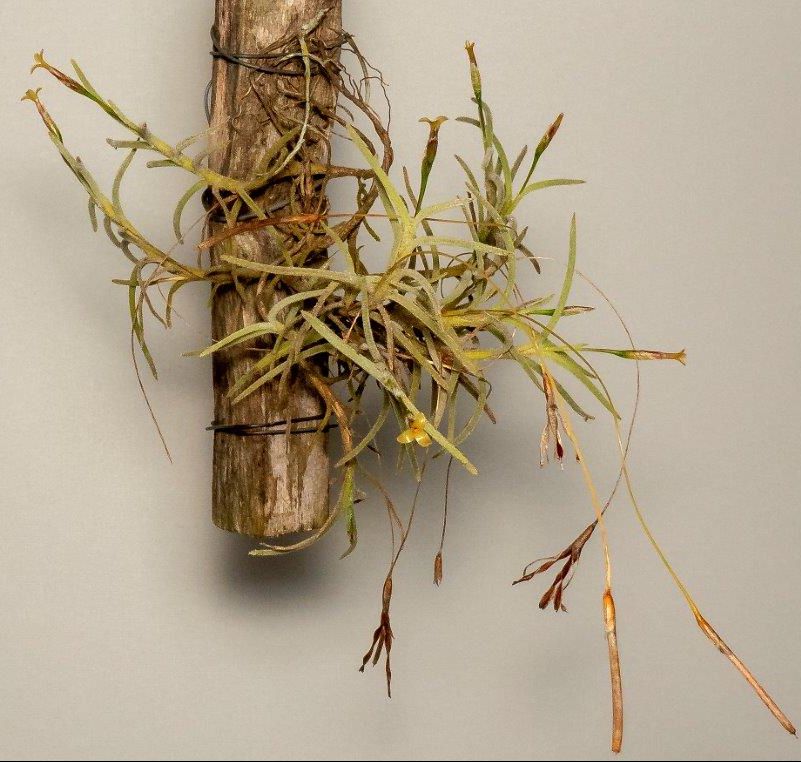
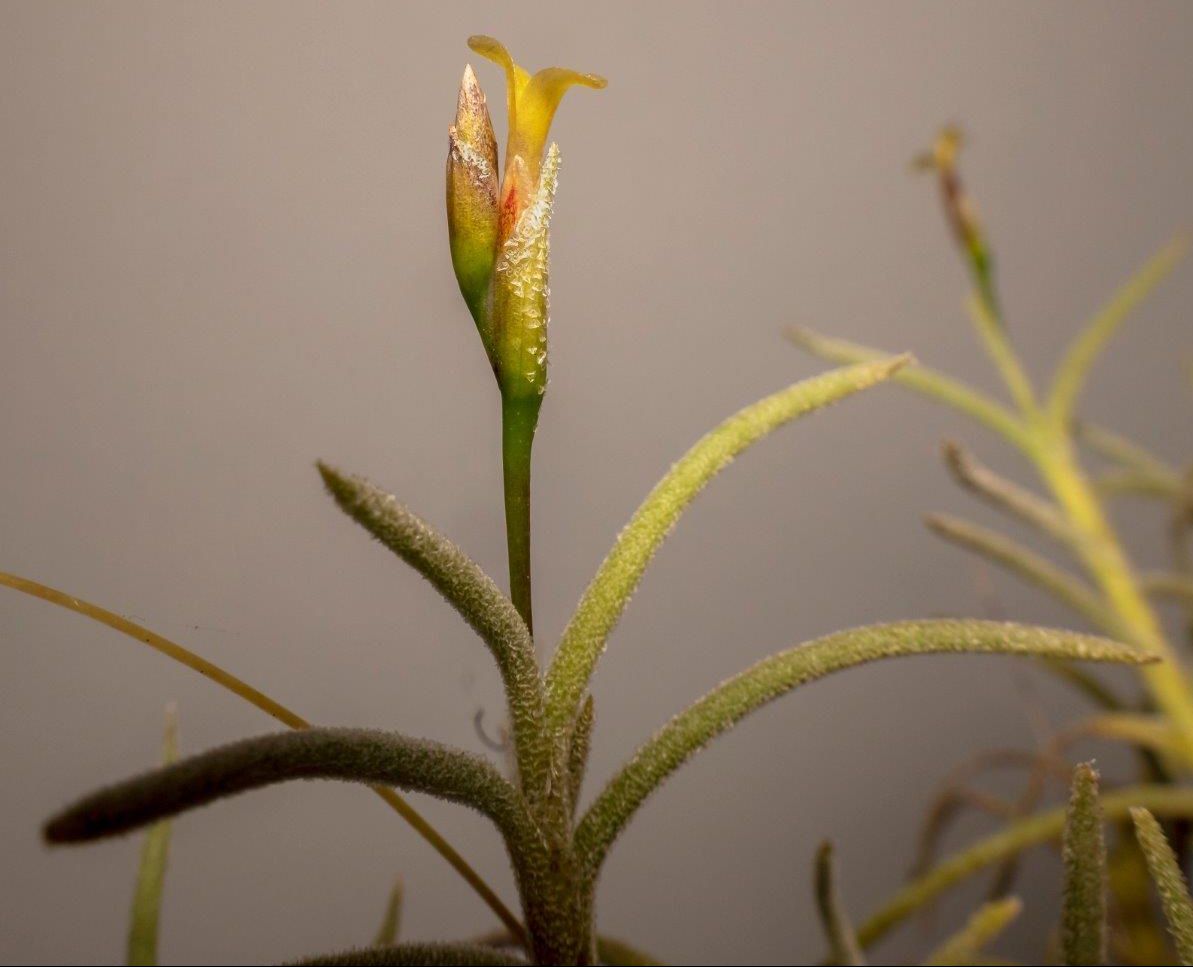

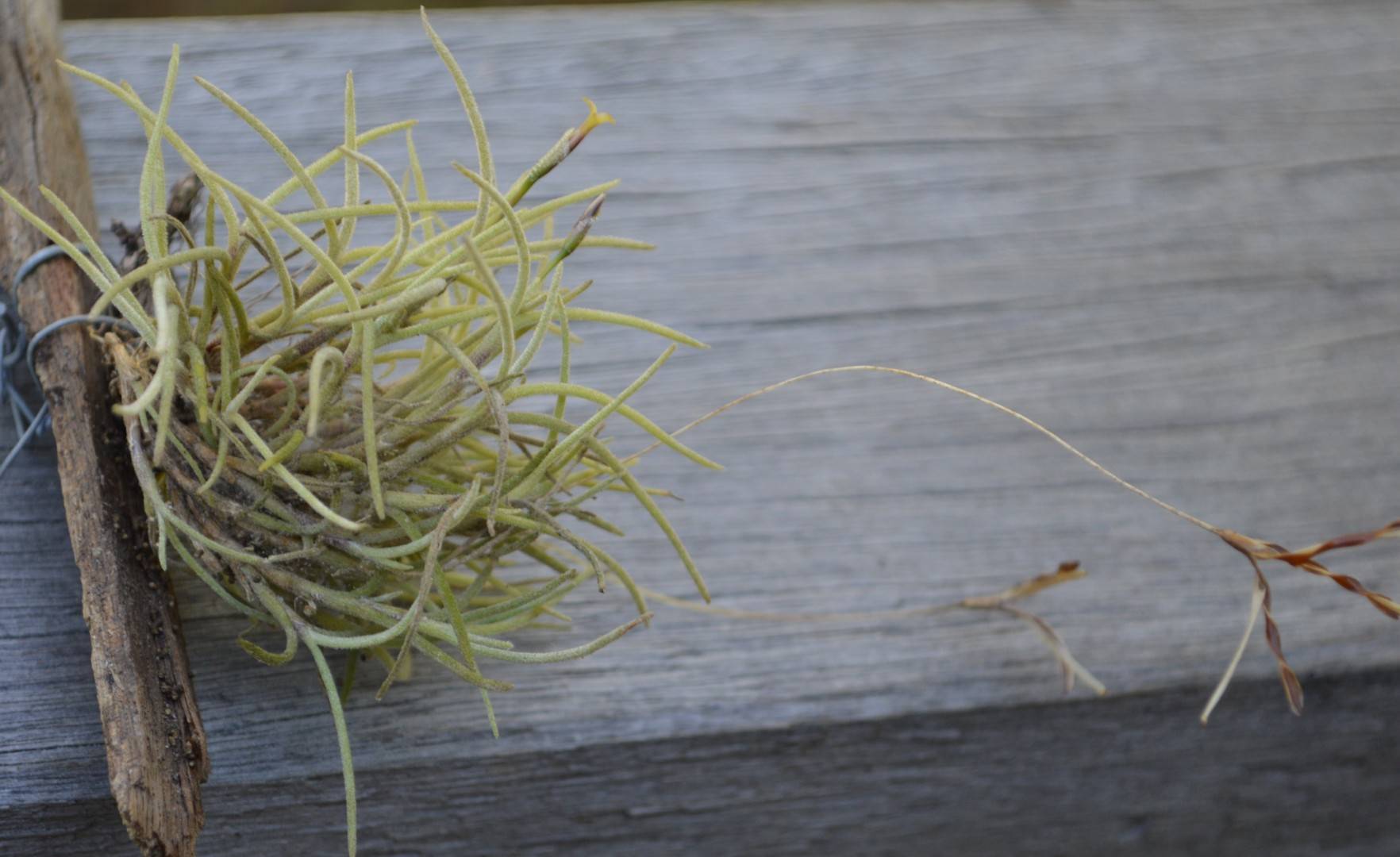

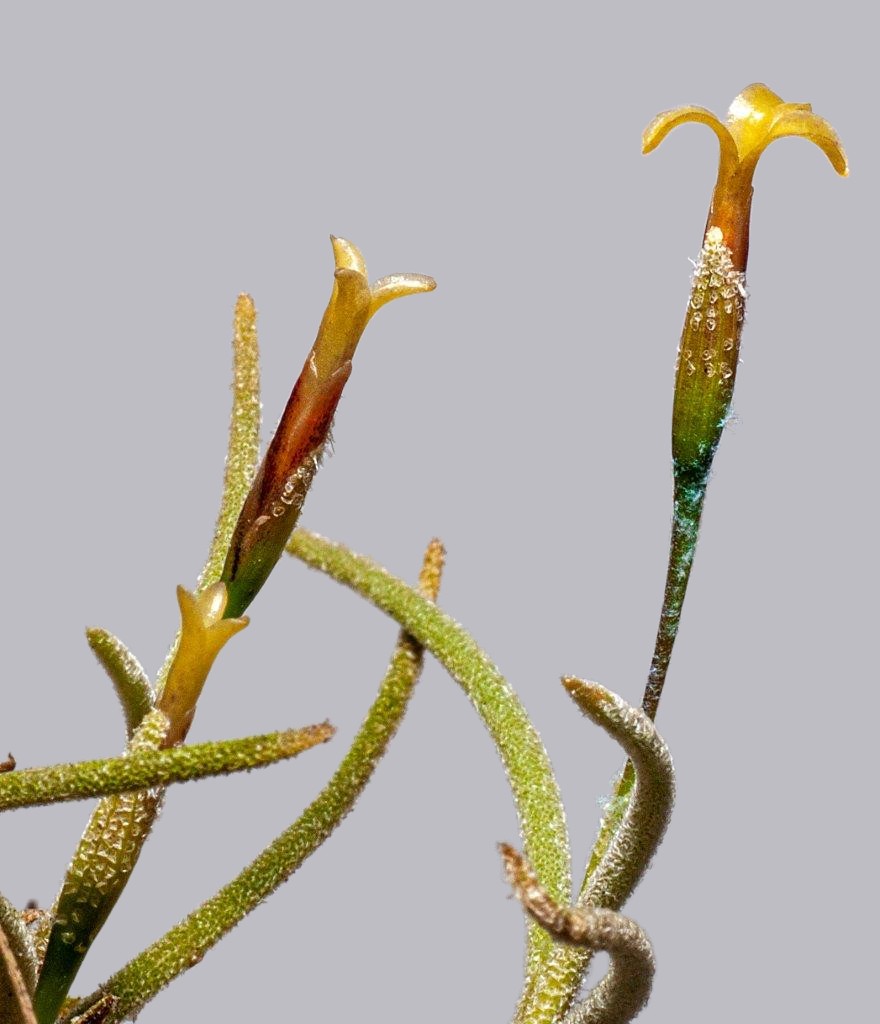
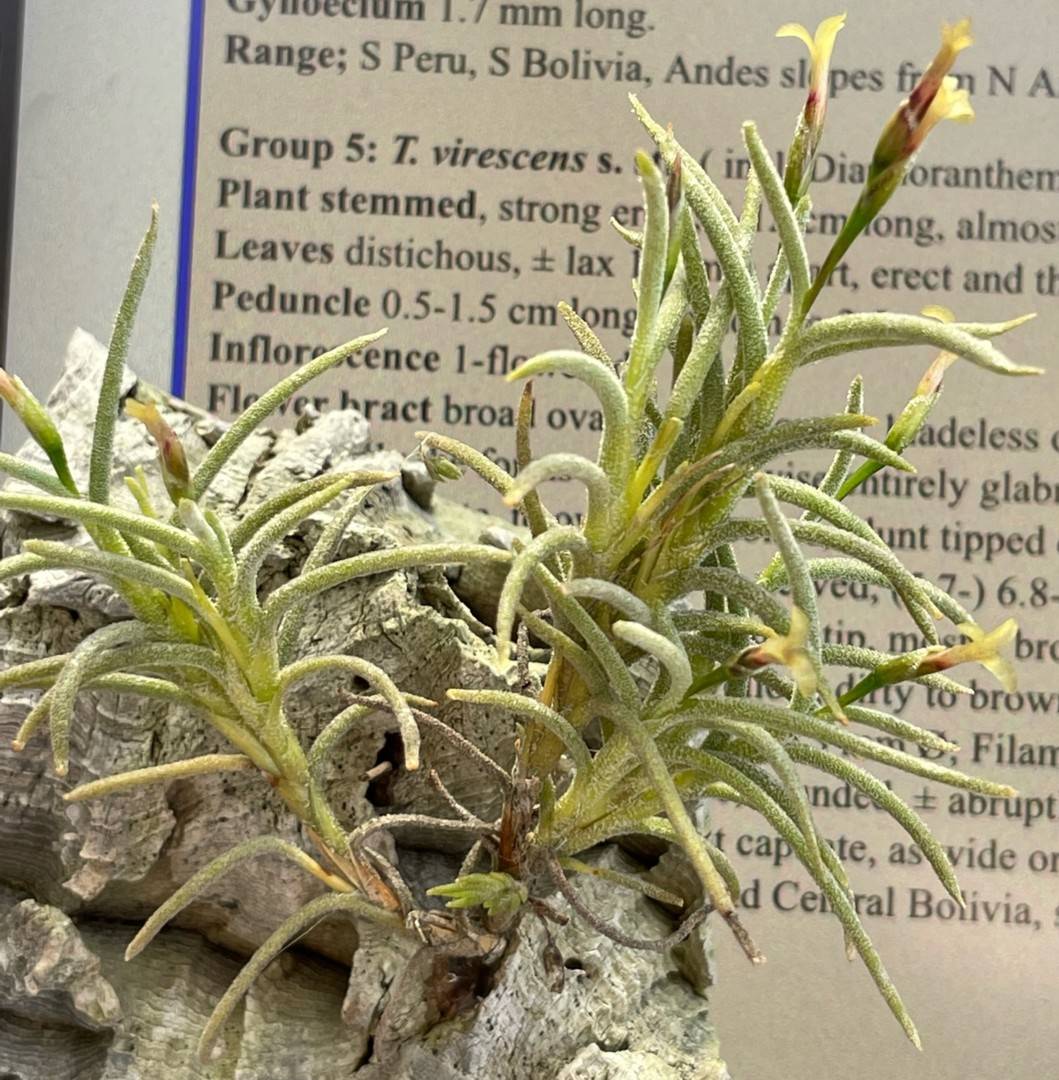
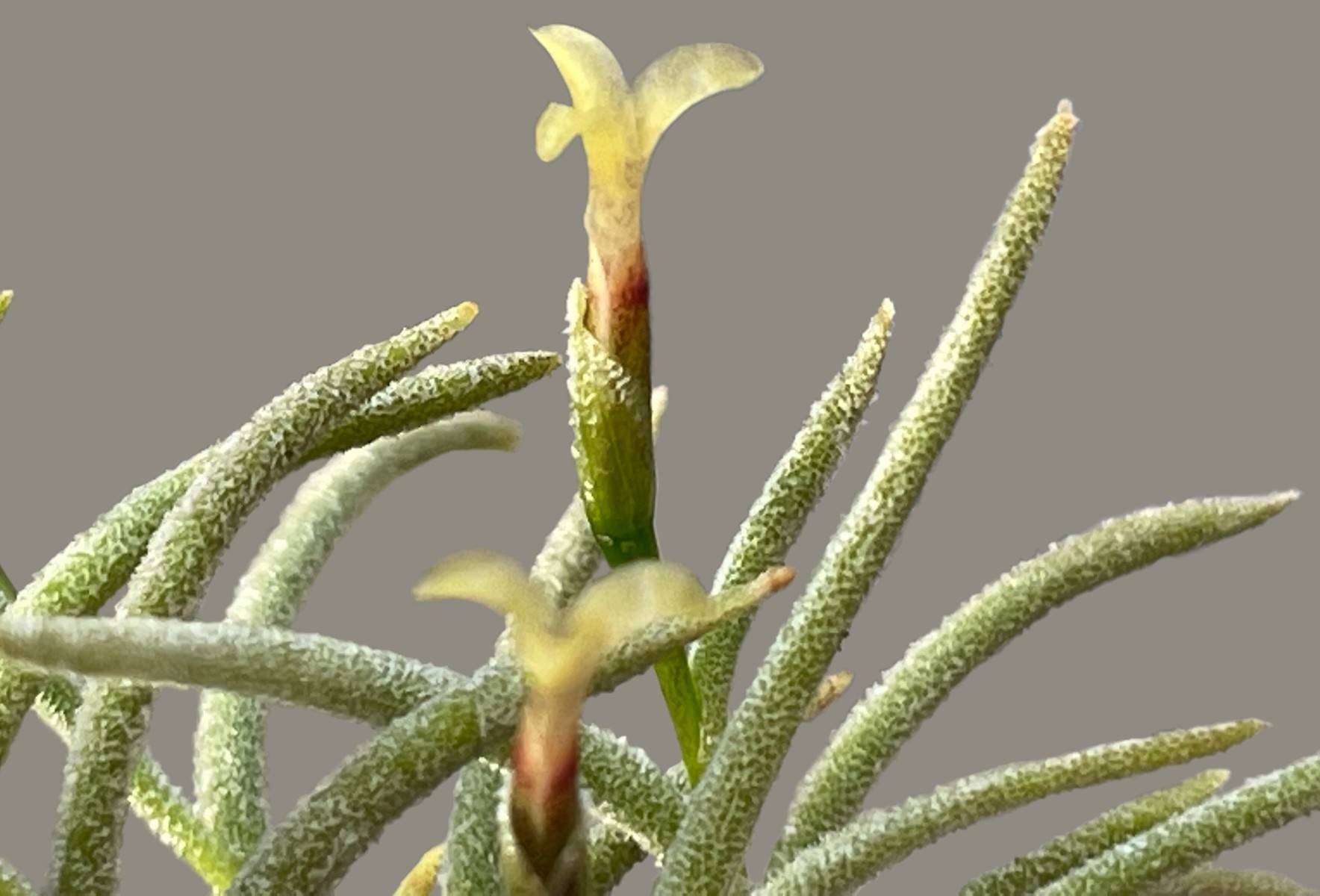
Group 1: T. cordobensis (incl. T. cordobensis, T. recurvate sensu Grisebach, T. capilaris forma cordobensis, T. dependens, T. dependens var perusneoides, T. dependens var. percordobensis, T. dependens forma perusneoides, T. dependens forma percordobensis) Drawings 83, 84, 85, 86, 87, 88, & 89.
Plant short stemmed, few or not branched, 8-10 cm long
Leaves distichous, lax on stem and spaced 4-7 mm apart, bent.
Sheath 8-10 mm long, ca. 5mm wide, ovate lanceolate, nerved, scaled
Blade round in cross section, 0.8-1 mm Ø, dense grey scaled, 4-6 cm long.
Peduncle 3-5 cm long, seldom shorter or missing, glabrous or seldom scaled
Inflorescence 1-flowered, very seldom 2-flowered
Flower bracts ovate, mostly wholely scaled, seldom in the upper ½ or the tip scaled, with blade 0.8-3 mm long, 5-7(-8)-nerved, (5.7-) 7.5-9.1 (-11) mm long, (4.1-)4.4-5.5 (-5.8) mm wide,
Sepals broad lineal, seldom narrow triangular, tip rounded, glabrous, seldom at or above the middle with few scales, posterior pair 3/4-4/5 connate, anterior much less connate, midnerve always passes through to the tip, side nerves mostly clearly shorter or sometimes missing, (1-) 3-4 (-5)-nerved, (6-) 6.5-8.8 (-9.8) mm long, (1.4-) 1.7-1.8 (-2.1) mm wide, seldom at the base with raphides,
Petal tongue shaped, the upper 1/3 mostly somewhat wider and narrow rhomboid, seldom below the middle at its widest, tip rounded, 3-4 (-5)-nerved, (8.5-) !0.7-12.9 (-13.7) mm long, (1.4-) 1.6-1.8 (-2.1) mm wide, with raphides, light yellow, yellow, light to dark brown, often flecked;
Anthers (1.1-) 1.4-1.7 (-2.1) mm long, 0.2-0.3 mm Ø, Filament basifixed, whitish, 1-nerved, (2.9-) 3.3-3.8 (-4.2) mm long, 0.15 mm wide;
Ovary inverted conical cylindric, very quickly narrows to a slender style, 0.8-1.1 (-1.5) mm Ø; Style a column, about 2/3 as long and ¼-1/3 as wide as the ovary; Stigma flat capitate, as wide or a little wider than the style; Gynoecium (2.4-) 2.7-3.3 (-3.8) mm long.
Range: Very isolated in Central Peru, from NW Bolivia Andean slopes over central and S Bolivia, N and from all Mid Argentina, Sierra de Cordoba, Mid Chile (seldom Coquimbo) and Central Paraguay ( underflows of Rio Pilcomayo)
Group 2: T. cordobensis “var tucumanensis” nom nud ( Drawings 90, and 91.)
Plant very similar to T. virescens s. str.
Leaves short and ± straight, 8-15 mm long
Peduncle missing or very short
Inflorescence 1-flowered
Flower bracts ovate, with short blade, ± glabrous or the upper ¼ and edges to the middle scaled, (3-) 5-nerved, (4.2-) 6.8-8 mm long, (3.9-) 4.6-5.1 mm wide,
Sepals glabrous, broad lineal, tip broad round, posterior pair 2/3-3/4 connate, anterior very little connate, the posterior pair sometimes weakly keeled, (1-) 3-nerved, (5-) 5.9-7 (-7.6) mm long, 1.6-2 mm wide, mid nerve goes to the tip, side nerves somewhat shorted;
Petals tongue shaped, to the tip mostly equally wide, seldom weakly wider, with broad round tip, 3-nerved, with raphides, (9.1-) 9.8-11.3 mm long, 1.4-1.8 mm wide, light yellow;
Anthers (1-) 1.3-1.6 mm long. 0.2-0.25 mm Ø, Filament basifixed, whitish, 1-nerved, (3.1-) 3.8-4.3 mm long, 0.15 mm wide,
Ovary inverted conical cylindric, abruptly narrows to a slender style, 1.8-2,1 (-2.7) mm long, 1-1.2 mm Ø; style a column, about ½-2/3 as long and 1/3 as wide as the ovary;
stigma flat capitate, somewhat as wide as the style; Gynoecium 2.8-3.6 (-3.9) mm long.
Range: Argentina, isolated in W Salta, Tucuman and the the Sierra de Cordoba.
Group 3: T. propinqua ( incl. stolpi, dependens var sanzini and virescens var sanzinii) Drawings 100, 101, and 102)
Plant distinctly stemmed, 5-12 cm long, few branches;
Leaves distichous, laxly about 3-6 mm apart, spreading or bent over, occasionally the tip is a little bent over to the front, 7-10 (-13) mm long, round, 1 mm Ø,
Peduncle 1-3 cm long, glabrous, pseudoaxillary;
Inflorescence 1-flowered,
Flower bract long ovate, often with short blade, scaled or edges glabrous or the upper ¼ scaled, (5-) 6-8-nerved, (4.9-) 6.2-7.5 mm long, (3.6-) 3.9-4.2 (-4.7) mm wide;
Sepals lanceolate, the tip mostly diminishing and the broadest near the base, the tip rounded, glabrous or along the nerves laxly scaled in the upper 2/3, 3(-5)- nerved, (5.1-) 5.5-6.2 mm long, (1.2-) 1.7-2 mm wide, posterior pair often ± keeled, 2/3-3/4 connate, anterior very little connate;
Petals spoonshaped, flat, the upper 1/3 mostly with long oval platte, very seldom below the middle at it widest, tip rounded, 3-5-nervec, with raphides, 7.2-8.5 (-9) mm long, 1.2-1.5 mm wide, yellow to brown, flowers weakly scented;
Anthers0.9-1.1 mm long, 0.2 mm Ø; filament basifixed, whitish, 1-nerved, 2.1-2.9 mm long, 0.1 mm wide,
Ovary inverted ovate cylindric, abruptly narrowing to a short sturdy style, (1.3-) 1.8-2.8 (-3.3) mm long, (0.8) 1-1.4 mm Ø; Style 0.3-0.5 mm long, 0.35-0.45 mm Ø; stigma flat, wider than the style; Gynoecium (1.8-) 2.6-3.2 (-3.7) mm long
Range: Andes in Central and S Peru, Bolivia and N Argentina (Jujuy) and again in Mid Argentina ( Mendoza) and Mid Chile ( Coquimbo and Santiago)
Group 4: T. propinqua “var” (= non pusilla Gillies ex Baker!) (Drawing 105)
Plant small, distinctly stemmed, 1-8 cm long.
Leaves bent to the front of the stem, but laxly distichous 1.5-3 mm apart, round, 0.5-1 mm Ø, 3-5 (-7) mm long
Peduncle missing or seldom very short (to 5 mm)
Inflorescence 1-flowered
Flower bract ovate triangular, tipped, the upper 1/2 scaled, with blade resting on the back, 5-nerved, 5 mm long, 3.3 mm wide;
Sepals triangular, tipped, widest at base, posterior pair 2/3 connate, anterior almost free, in the upper ½ and along the nerves scaled, 3-nerved, 5.1 mm long, 2 mm wide,;
Petals lanceolate, clearly narrowing above, widest at about the lower 1/3, the tip rounded, with raphides, 3-nerved, 6.9 mm long, 1.4 mm wide, dark violet;
Anthers 1.1 mm long, 0.2 mm Ø, Filament basifixed, whitish, 1-nerved, 1.9 mm long, 0.1 mm wide;
Ovary inverted conical cylindric, abruptly narrows to a sturdy style, 1.3 mm long, 0.9 mm Ø, Style 0.3 mm long, 0.35 mm Ø; stigma flat, wider than the style;
Gynoecium 1.7 mm long.
Range; S Peru, S Bolivia, Andes slopes from N Argentina to Mid Argentina (Mendoza), in Sierra de Cordoba and in mid Chile ( Coquimbo)
Group 5: T. virescens s. str. ( incl. Diaphoranthema virescens, T. capillaris forma virescens and T. williamsii) Drawings 93, 94, 95, 96, 97, 98, 99, 103, 104)
Plant stemmed, strong erect, 6-12 cm long, almost not branched.
Leaves distichous, ± lax 1-3 mm apart, erect and the tip bent over from the stem, seldom somewhat bent back, round, soft, 8-23 (-40) m long, 1-1.5 mm Ø;
Peduncle 0.5-1.5 cm long, seldom to 3.5 cm.
Inflorescence 1-flowered.
Flower bract broad ovate to long ovate, bladeless or with to 4 mm long blade, glabrous, 1/4-1/2 or wholely scaled, blade mostly resting on the back of the tip of the bract (particularly the forms with otherwise entirely glabrous bract), (3-) 7-9 (-11)-nerved, (5-) 7-9 (-11) mm long, (4-) 5.5-7 (-7.6) mm wide;
Sepals lanceolate, to ovate lanceolate, blunt tipped or broad rounded, at widest near the base, glabrous, seldom 1/3-2/3 laxly scaled, posterior pair (1/2-) 3/5-5/6 connate, anterior almost free, (3-) 5-7 (-8)-nerved, (5.7-) 6.8-8.2 (-9) mm long, (1.6-) 2-3.1 (-3.8) mm wide,
Petals tongue shaped, broad round at tip, mostly broadest in the lower 1/3, often with oval ± established platte, with raphides, (3-) 5 (-7)-nerved, (6,6-) 8.8-10 (-11.3) mm long, (1.3-) 1.8-2.6 (-2.9) mm wide, yellow, dirty to brown yellow, sometimes flecked;
Anthers (1-) 1.4-1.7 mm long, 0.2-0.3 mm Ø; Filament basifixed, whitish, 1-nerved, (2.1-) 2.7-3.2 (-4.1) mm long, 0.1-0.15 mm wide,
Ovary inverted conical cylindric, rounded, ± abruptly narrowing to the style, (1.2-) 1.7-2.4 mm long, (1.1-) 1.4-1.8 mm Ø, Style short, pillar like, about 1/6-2/5 as long and 1/3 as wide as the ovary; Stigma flat capitate, as wide or wider than the style; Gynoecium (1.9-) 2.4-3 (-3.4) mm long
Range: Central to S Peru, NW and Central Bolivia, seldom in S Bolivia and N Argentina, isolated in Mid Argentina (Sierra de Cordoba, Mendoza), Mid Chile (Coquimbo, Santiago)
Detail from S&D
232. Tillandsia capillaris Ruiz & Pavon, Fl. Peruv. 3: 42, pl. 271, fig. c. 1802.
Plant very variable in both size and form, to 16 cm long in flower; roots present; stems many from a single point, densely massed, simple or branched.
Leaves distichous, mostly 1-4 cm long, rarely shorter or up to 9 cm long, densely and finely pruinose-lepidote with cinereous to ferruginous scales; sheaths usually elliptic, thin, several-nerved, densely lepidote except where covered by the next below; blades erect to spreading, straight or rarely contorted, linear and less than a 2 mm in diameter or narrowly triangular and thicker according to the form represented.
Scape from almost none to 8 cm long, mostly slender, always naked, glabrous or slightly lepidote toward apex, developed almost wholly after anthesis.
Inflorescence normally 1-flowered, rarely 2-flowered.
Floral bracts ovate, acute or apiculate, thin with 3 or more strong nerves, densely lepidote to glabrous, usually equaling or exceeding the sepals;
Flowers subsessile.
Sepals lanceolate, acute or obtuse, to 8 mm long, connate posteriorly;
Petals narrow with blade scarcely distinct, white, yellow or brown;
Stamens deeply included, exceeding the pistil.
Capsule slenderly cylindric, abruptly short-beaked, 10-20 mm long.
Key to the Forms of Tillandsia capillaris
1. Floral bracts with at least 5 strong nerves meeting near the apex. -> 2
1. Floral bracts with only 3 strong nerves meeting near the apex, other nerves if any short and with free apices. -> forma hieronymi
2. Scape evident after anthesis and mostly exceeding the leaves. . -> 3
2. Scapes never elongating much even after anthesis, mostly shorter than the leaves. . -> forma virescens. - now species
3. Floral bracts glabrous or scantly and deciduously lepidote; scapes conspicuously pseudo-axillary. . -> 4
3. Floral bracts densely and persistently lepidote; scapes usually but not invariably terminal; leaves widely spaced so that the greater part of each sheath is uncovered. . -> forma cordobensis - (now virescens.)
4. Leaves slender and elongate, not over 2 mm in diameter, obtuse, loose and spreading. -> forma capillaris.
4. Leaves short and stout, mucronate, appressed and ascending so that they form an almost continuous plane. . -> forma incana.
Tillandsia capillaris forma capillaris
Diaphoranthema capillaris (Ruiz & Pavon) Beer, Bromel. 153. 1857.
Tillandsia lanuginose Gillies ex Baker, Jour. Bot. London 16: 237. 1878; nomen in synon.
Tillandsia capillaris var ß. Lanuginose Mez, DC. Monogr. Phan. 9: 879. 1896. Type. Mendoza, Argentina, Gillies s n (K, K photo), Sep 1823.
Tillandsia capillaris forma typical L. B. Smith, Proc. Am. Acad. (Contr. Gray Herb. 106) 70: 210. 1935.
Leaf-blades slender, elongate.
Scapes pseudo-axillary, elongate.
Floral bracts with 5 or more nerves, glabrous or subglabrous.
TYPE. Ruiz & Pavon s n (isotype BM, GH photo; P), without exact locality, Peru.
DISTRIBUTION. Saxicolous and epiphytic, 350-3600 m alt, Peru and Bolivia to Chile and Argentina.
Tillandsia capilaris forma incana (Mez) L. B. Smith, Proc. Am. Acad. (Contr. Gray Herb. 106) 70: 211. 1935.
Tillandsia incana Gillies ex Baker, Jour. Bot. London 16: 238. 1878; nomen in synon. Based on Gillies s n (K), Mendoza, Argentina.
Tillandsia propinqua Gay var ß saxicola Hieronymus, Icon. & Descript. Argent. 16, pl. 3, fig. 4. 1885. Type Quebrada del Choro, east of los Gigantes, Sierra Chica, Cordoba, Argentina, Hieronymus s n (B), 4 Dec 1878.
Tillandsia capilaris Ruiz & Pavon var ? incana Mez, DC. Monogr. Phan. 9: 879. 1896.
Tillandsia permutata Castellanos, Lilloa 11: 145. 1945. Type. Yacanto, Cordon Central, Cordoba, Argentina, Hauman s n (BA 1573), Jul 1920.
Leaf-blades short and stout, mucronate, appressed and ascending so that they form an almost continuous plane.
Scapes evident after anthesis and mostly exceeding the leaves, pseudo-axillary.
Floral bracts with at least 5 strong nerves meeting near the apex, glabrous or subglabrous.
TYPE. Gillies s n (K, K photo), foot of the cordillera near Mendoza, Argentina.
DISTRIBUTION. Saxicolous and epiphytic in dry habitats, 786-4000 m alt, Bolivia. northwestern Argentina.
Tillandsia capilaris forma cordobensis (Hieronymus) L. B. Smith, Proc. Am. Acad. (Contr. Gray Herb. 106) 70: 211. 1935. now species virescens
Tillandsia cordobensis Hieronymus, Icon. & Descript. Argent. 10, pl. 3, fig. 1. 1885.
Tillandsia recurvata sensu Grisebach, Pl. Lorentz., Gott. Abh. 19: 225. 1874; non Linnaeus, 1762.
Leaves widely spaced so that the greater part of each sheath is uncovered.
Scapes evident after anthesis, usually terminal, mostly exceeding the leaves.
Floral bracts with at least 5 strong nerves meeting near the apex, densely and persistently lepidote.
TYPE. Hieronymus 349 (holotype B, B photo 1191/16; isotype, CORD), Sierra Achala, Cordoba, Argentina, 1875.
DISTRIBUTION. Epiphytic in dry habitats, 900-3000 m alt, Peru, Bolivia, Chile, Argentina.
Tillandsia capilaris forma virescens (Ruiz & Pavon) L. B. Smith, Proc. Am. Acad. (Contr. Gray Herb. 106) 70: 212. 1935. now species
Tillandsia virescens Ruiz & Pavon, Fl. Peruv. 3: 43, pl. 270, fig. b. 1802.
Tillandsia propinqua Gay, Fl. Chil. 6: 15. 1853. Type. Coquimbo, Chile, Gay s n (P, GH photo).
Diaphoranthema virescens (Ruiz & Pavon) Beer, Bromel. 154. 1857.
Tillandsia pusilla Gillies ex Baker, Jour. Bot. London 16: 237. 1878. Type. Mendoza, Argentina, Gillies s n (K, K photo).
Tillandsia lichenoides Hieronymus, Icon. & Descript. Argent. 17. 1885. Type. Guachipas, Salta, Argentina, Lorentz & Hieronymus 1180 (B, GH photo; S), 1873.
Tillandsia stolpi Philippi, Anal. Univ. Chile 91: 614. 1895. Type. Naltagua, Victoria, O'Higgins, Chile, Stolp s n (SGO, GH photo), 1888.
Tillandsia williamsii Rusby, Bull. N. Y. Bot. Gard. 6: 489. 1910. Type. Yura, Arequipa, Peru, R. S. Williams 2539 (NY), 11 Aug 1901.
Tillandsia dependens var sanzini Hicken, Physis 1: 388. 1914. Type. Precordillera,
Mendoza, Argentina, Sanzin s n (SI 382), 2 Nov 1913.
Tillandsia virescens var sanzinii (Hicken) Castellanos, Gen. & Sp. Pl. Argent. 3: 337. 1945.
Tillandsia hieronymi var lichenoides (Hieronymus) Castellanos, Gen. & Sp. Pl. Argent. 3: 343. 1945.
Scapes never elongating much even after anthesis.
Floral bracts with at least 5 strong nerves meeting near the apex.
TYPE. Ruiz & Pavon s n (holotype MA n v, isotype F), Huanuco, Peru.
DISTRIBUTION. Saxicolous and epiphytic in dry habitats, 500-4000 m alt, Peru, Bolivia, Chile, and Argentina.
Tillandsia capilaris forma hieronymii (Mez) L. B. Smith, Proc. Am. Acad. (Contr. Gray Herb. 106) 70: 213. 1935.
Tillandsia hieronymii Mez, DC. Monogr. Phan. 9: 876. 1896.
Tillandsia propinqua sensu Grisebach, Symb. Argent., Gott. Abh. 34: 334. 1879; non Gay, 1853. Based on Hieronymus 124 (B, CORD, F, US), Cordoba, Argentina, 12 Nov 1876.
Tillandsia dependens Hieronymus ex Mez, DC. Monogr. Phan. 9: 880. 1896. Type. Sierra Achala, Cordoba, Argentina, Hieronymus 781 (B, CORD, F, US), 30 Jan 1877.
Tillandsia dependens var a perusneoides Mez, DC. Monogr. Phan. 9: 881. 1896; the typical variety.
Tillandsia dependens var ß percordobensis Mez, DC. Monogr. Phan. 9: 881. 1896. Type. Sierra de Cordoba, Cordoba, Argentina, Hieronymus 352 (B, F photo 11491; CORD).
Tillandsia dependens forma perusneoides (Mez) Castellanos, An. Mus. Nac; Hist. Nat. Buenos Aires 37: 500. 1933.
Tillandsia dependens forma percordobensis (Mez) Castellanos, An. Mus. Nac. Hist. Nat. Buenos Aires 37: 500. 1933.
Floral bracts with only 3 strong nerves meeting near the apex, other nerves if any short and with free apices.
TYPE. Hieronymus 124 (holotype B, isotypes CORD, F, G, GH, GOET, M, US), Cor¬doba, Argentina, 12 Nov 1876.
DISTRIBUTION. Epiphytic in dry habitats, 300-3600 m alt, Bolivia and northwestern Argentina.
Detail from Baker 1889
5. T. PROPINQUA C. Gay Fl. Chil. ii. 15; Hieron. Fl. Cordob. t. 3, figs. 2-4.
T. lanuginose Gillies.
Stems densely tufted, 1-4 in. long, simple or forked.
Leaves laxly placed on the stem, erectopatent, subterete from a clasping base, ?-½ in. long, ¼ lin. diam. at the middle, channelled down the lower part of the face, densely finely lepidote all over.
Peduncle very short, not bracteated.
Flowers always solitary.
Flower-bract oblong, lepidote, ¼ in. long, tightly clasping the calyx.
Sepals linear-oblong, naked, ¼ in. long. Capsule cylindrical, ½-¾ in. long.
Hab. Andes of Chili, C. Gay ! Cuming 167! Bridges 534! Argentaria, Lorentz ! Hieronymus 422! Mendoza, Gillies ! Andes of Bolivia, up to 12000-18000 ft., Pentland !
Protologue
Tillandsia williamsii Rusby, Bull. N. Y. Bot. Gard. 6: 489. 1910. Type. Yura, Arequipa, Peru, R. S. Williams 2539 (NY), 11 Aug 1901.
Densely gray-lepidote; stems densely fascicled, 5-7 cm. long, spreading; sheaths 3-4 mm. long, completely clasping, strongly ribbed, abruptly contracted into the blades, which are 15-30 mm. long, 3 mm. wide, slightly wider at about the middle, lightly folded, long-acuminate; pedicels solitary, 8-12 mm. long, slender, straight, nearly glabrous, nerved; flowers not seen; bract sheathing the calyx, broadly ovate, strongly ribbed; sepals sheathing the base of the fruit, unequal, the longest 5-6 mm. long, broadly ovate, obtuse, nerved; capsule 15-18 mm. long, slightly broader above, the valves of the exocarp yellow, separating from those of the purple endocarp, and exceeding them, short-rostrate; seeds oblong, brown, very small.
"On rock, Yura, 8400 ft., Aug. 11, 1901" (No. 2439).
Detail from Mez 1935
381. T. Williamsii Rusby in Bull. N. York Bot. (Gard. VI. (1910) 489.
Dense cinereo-lepidota. Caules dense fasciculati, 5-7 cm longi, patentes; vaginae 3-4 mm longae, omnino, involutae, valide nervosae, in laminas 15-30 mm longas, 3 mm latas, medio paullo dilatatas, leviter complicatas, longe acuminatas subito contractae. Scapi solitarii, 8-12 cm longi, graciles, recti, fere glabri, nervosi. Floras ignoti, bracteis calycis basin invaginantibus, late ovatis, valde nervosis. Sepala fructum basi vaginantia, inaequalia, longiore 5-6 mm metiente, late ovato, obtuso, nervoso. Capsula 15-18 mm longa, interne paullo crassior, exocarpii valvis luteis, ab endocarpio purpureo solutia idque superantibus, breviter rostratis. Semina oblonga, brunnea, minuta.
Bolivia: bei Yura, an Felsen (Rusby n. 2539). - Non vidi; diagn. ex cl. Rusby, l. c.
382. T. cordobensis Hieron. Ic. et Descript. Argent. (1885) 10, t. 3 fig. 1; Castellanos in Anal. Mus. Argent. Ci. Nat. XXXVII. (1933) 500.
- T. recurvata Griseb. (non alior.) in Goett. Abh. XXIV. (1879) 334.
Manifeste caulescens, usque ad 45 mm alta, globose pulvinata. Folia optime distiche ordinata, 40-60 mm longa, tenuiter subulata, 1-1,5 mm crassa, lepidibus magnis dense pruinosa. Scapus terminalis, exsertus, nudus, foliis usque ad triplo longior, filiformis, teres, glaber, subflexuosus. Spica in florem unicum bractea 5-nervia, ovata, 7-10 mm longa, amplexicauli, furfuracea suffultum reducta. Flos sepalis antico basi breviter cum posticis alte inter sese connatis coalitis, erectis, 4-nerviis, glabris, sublinearibus, obtusis, ad 8 mm longis. Petala sepalis paullo longiora, ochroleuca, spathulata, obtusa. Stamina profunde inclusa, stylum superantia.
Argentina: Prov. Cordoba (Hieronymus n. 349, Kurtz n. 6927, Stuckert n. 25, 1919, 3126, 8398, 10891, 11744, 11786, 11839a, 11840); Prov. Salta ( Kurtz n. 4067); Prov. Tucuman (Hauthal n. 383 e. p.); Prov. Jujuy (Inostrosa n. 2338, Holmberg in herb. Min. Agr. n. 6973) ; Prov. Chaco (Muello ) ; Prov. Catamarca (Berg n.1132); Corrientes (Niederlein n. 203). Bolivia (Bang n. 1154a, Hauthal n. 352, Mandon n.1177 Pearce, Rusby n. 2165). Paraguay (Morong n. 492a, 876). Uruguay: bei Mercedes (Osten n. 2943).
385. T. Stolpii Phil. in Anal. Univers. Chile XCI. 1895 (1896) 614:
Caespitosa, humilis; foliis subdistichis, cylindricis, apice fere subulatis, cinereo-lepidotis; floribus axillaribus subsessilibus; bractea ovata, acuminata, 5-costata; foliolis calycinis bracteam vix superantibus, in fructus maturitate stramineis, apice nigris, nervosis, margine late scariosis; petalia ignotis; capsula calycem bene aequante.
Chile: in praedio Naltagua, dept. Victoria prov. O'Higgins, invenit in Cereis epi-phyticam Carolus Stolp - Non vidi: diagn. ex cl. Philippi. 1. c.
Tillandsia tomasii J. J. Halda, Acta Mus. Richnov., Sect. Natur. 12(2): 57-68. 2005
Walter Till 6/2006 considers this to be the old ‘T. williamsii’ and thus a T. virescens
HOLOTYPUS HIC DESIGNATUS: PR. no. 11953; leg. J. J. Halda 25.11. 2005; no. JJH/0511482.
DESCRIPTION: Differs from similar T. capilaris in having pendent deep yellow rotate flowers, bracts membranaceous, glabrous, costate; leaves succulent, densely white-lepidote, black spotted with serrate-dentate margin and acutely mucronated top.
Very densely pulvinate to 30 cm across; branches caulescent, up 25 cm long, densely branched toward apex.
Leaves imbricately distichous, succulent, acutely mucronate, up 15 (25) mm long, recurvate to flexuose, angulate-subulate, rigid, densely whitish lepidote.
Scape short, hidden among leaves, to 10 (rarely to 25) mm long, leafless, very thin, glabrous, more or less angulate, strictly pendent.
Flower single, pendent, pseudo-terminal;
bract single, spathaceous, membranous, glabrous, ovate, prominently veined, acute, to 8 mm long;
sepals ca 10 mm long, coriaceous, glabrous, subelliptic, sharp, more or less connate, (Latin says anterior connate 2mm posterior pair connate 5mm) prominently veined.
Corolla tubiform, ca 15 mm long,
petals longer than sepals, lingulate-obovate, rotate.
Stamens included, style much shorter.
Capsule cylindric ca 10 mm long, exocarpical valves succulent, yellowish, endocarpium suffused purple.
Seeds oblong, brownish, tiny.
DISTRIBUTION: W Bolivia, dept. Potosi, on red sandstone-walls E of town Potosi, ca 2950 m.